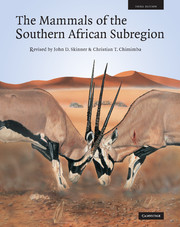Book contents
- Frontmatter
- Contents
- Editorial board
- Acknowledgements
- Foreword
- Preface
- The Mammal Research Institute
- R. H. N. Smithers
- Explanatory notes
- SUPERCOHORT AFROTHERIA
- COHORT PAENUNGULATA
- Order HYRACOIDEA
- Order PROBOSCIDEA
- Order SIRENIA
- SUPERCOHORT EUARCHONTAGLIRES COHORT GLIRES
- COHORT EUARCHONTA
- SUPERCOHORT LAURASIATHERIA
- COHORT FERUNGULATA
- Bibliography
- Appendix 1 Conservation status of southern African mammals
- Appendix 2 Colloquial names
- Index of scientific names
- Index of English colloquial names
- List of subscribers
- Plate Section
- Plate Section
- Plate Section
- Plate Section
- Plate Section
- Plate Section
- Plate Section
Order HYRACOIDEA
from COHORT PAENUNGULATA
Published online by Cambridge University Press: 05 July 2013
- Frontmatter
- Contents
- Editorial board
- Acknowledgements
- Foreword
- Preface
- The Mammal Research Institute
- R. H. N. Smithers
- Explanatory notes
- SUPERCOHORT AFROTHERIA
- COHORT PAENUNGULATA
- Order HYRACOIDEA
- Order PROBOSCIDEA
- Order SIRENIA
- SUPERCOHORT EUARCHONTAGLIRES COHORT GLIRES
- COHORT EUARCHONTA
- SUPERCOHORT LAURASIATHERIA
- COHORT FERUNGULATA
- Bibliography
- Appendix 1 Conservation status of southern African mammals
- Appendix 2 Colloquial names
- Index of scientific names
- Index of English colloquial names
- List of subscribers
- Plate Section
- Plate Section
- Plate Section
- Plate Section
- Plate Section
- Plate Section
- Plate Section
Summary
THE HYRAXES ARE in many characters primitive or generalised subungulates that have changed, in the course of evolution, from fossil forms found in the Oligocene. By that time they had evolved into a large and diverse assemblage, represented by six genera and including species of much larger size than those known today. Gigantohyrax maguirei, one of the Plio–Pleistocene forms from Makapansgat in Limpopo Province, like so many other fossil species known from this period, was about three times larger than the extant rock hyrax (Procavia capensis). Gigantohyrax maguirei, known from the anterior two-thirds of a skull with full upper dentition, had already lost the second and third upper incisors and the canine possessed by earlier forms, and very closely resembled the extant rock hyrax in this aspect of its dental formula. Other smaller hyraxes are also known from this geological age, some, such as Procavia antiqua and the larger P. transvaalensis, occurring in fossil deposits at Taung and in the former Transvaal (Maglio & Cooke, 1978). Hyracoids have also been recovered from two kinds of breccia at Berg Aukus in Namibia. Several specimens of Heterohyrax have been described from the Late Miocene – most recently the species Heterohyrax auricampensis was reported with an estimated age of 10–9 Mya. Despite its age it cannot be generically distinguished from modern Heterohyrax but differs from the yellow-spotted rock hyrax (H. brucei) in having basally inflated molar cusps and less molarised anterior premolars (Rasmussen et al., 1996).
- Type
- Chapter
- Information
- The Mammals of the Southern African Sub-region , pp. 41 - 50Publisher: Cambridge University PressPrint publication year: 2005



